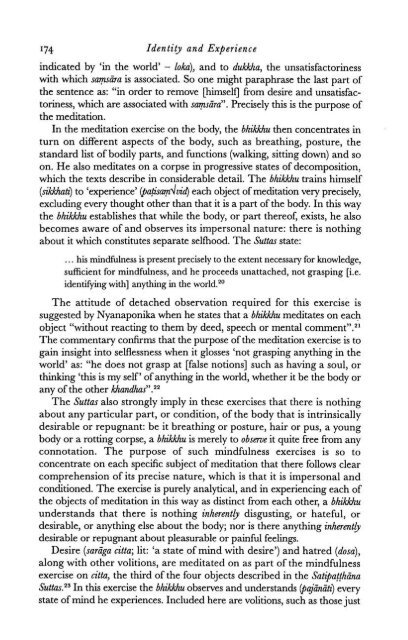Identity and Experience_Hamilton_1996
Identity and Experience_Hamilton_1996
Identity and Experience_Hamilton_1996
You also want an ePaper? Increase the reach of your titles
YUMPU automatically turns print PDFs into web optimized ePapers that Google loves.
I74<br />
<strong>Identity</strong> <strong>and</strong> <strong>Experience</strong><br />
indicated by 'in the world' - loka), <strong>and</strong> to dukkha, the unsatisfactoriness<br />
with which sa~ira is associated. So one might paraphrase the last part of<br />
the sentence as: "in order to remove [himself] from desire <strong>and</strong> unsatisfactoriness,<br />
which are associated with saysira". Precisely this is the purpose of<br />
the meditation.<br />
In the meditation exercise on the body, the bhikkhu then concentrates in<br />
turn on different aspects of the body, such as breathing, posture, the<br />
st<strong>and</strong>ard list of bodily parts, <strong>and</strong> functions (walking, sitting down) <strong>and</strong> so<br />
on. He also meditates on a corpse in progressive states of decomposition,<br />
which the texts describe in considerable detail. The bhikkhu trains himself<br />
(sikkhati) to 'experience' (pa6arndvid) each object of meditation very precisely,<br />
excluding every thought other than that it is a part of the body. In this way<br />
the bhikkhu establishes that while the body, or part thereof, exists, he also<br />
becomes aware of <strong>and</strong> observes its impersonal nature: there is nothing<br />
about it which constitutes separate selfhood. The Suttas state:<br />
. . . his mindfulness is present precisely to the extent necessary for knowledge,<br />
sufficient for mindfulness, <strong>and</strong> he proceeds unattached, not grasping [i.e.<br />
identifying with] anything in the world.20<br />
The attitude of detached observation required for this exercise is<br />
suggested by Nyanaponika when he states that a bhiWGhu meditates on each<br />
object "without reacting to them by deed, speech or mental comment".21<br />
The commentary confirms that the purpose of the meditation exercise is to<br />
gain insight into selflessness when it glosses 'not grasping anything in the<br />
world' as: "he does not grasp at [false notions] such as having a soul, or<br />
thinking 'this is my self' of anything in the world, whether it be the body or<br />
any of the other Wl<strong>and</strong>has" .22<br />
The Suttas also strongly imply in these exercises that there is nothing<br />
about any particular part, or condition, of the body that is intrinsically<br />
desirable or repugnant: be it breathing or posture, hair or pus, a young<br />
body or a rotting corpse, a bhikkhu is merely to obserue it quite free from any<br />
connotation. The purpose of such mindfulness exercises is so to<br />
concentrate on each specific subject of meditation that there follows clear<br />
comprehension of its precise nature, which is that it is impersonal <strong>and</strong><br />
conditioned. The exercise is purely analytical, <strong>and</strong> in experiencing each of<br />
the objects of meditation in this way as distinct from each other, a bhikkhu<br />
underst<strong>and</strong>s that there is nothing inherently disgusting, or hateful, or<br />
desirable, or anything else about the body; nor is there anything inherently<br />
desirable or repugnant about pleasurable or painful feelings.<br />
Desire (sariga citta; lit: 'a state of mind with desire') <strong>and</strong> hatred (dosa),<br />
along with other volitions, are meditated on as part of the mindfulness<br />
exercise on citta, the third of the four objects described in the Satz$a#hina<br />
S~ttas.~~ In this exercise the bhikkhu observes <strong>and</strong> underst<strong>and</strong>s (pnjrntlh) every<br />
state of mind he experiences. Included here are volitions, such as those just


